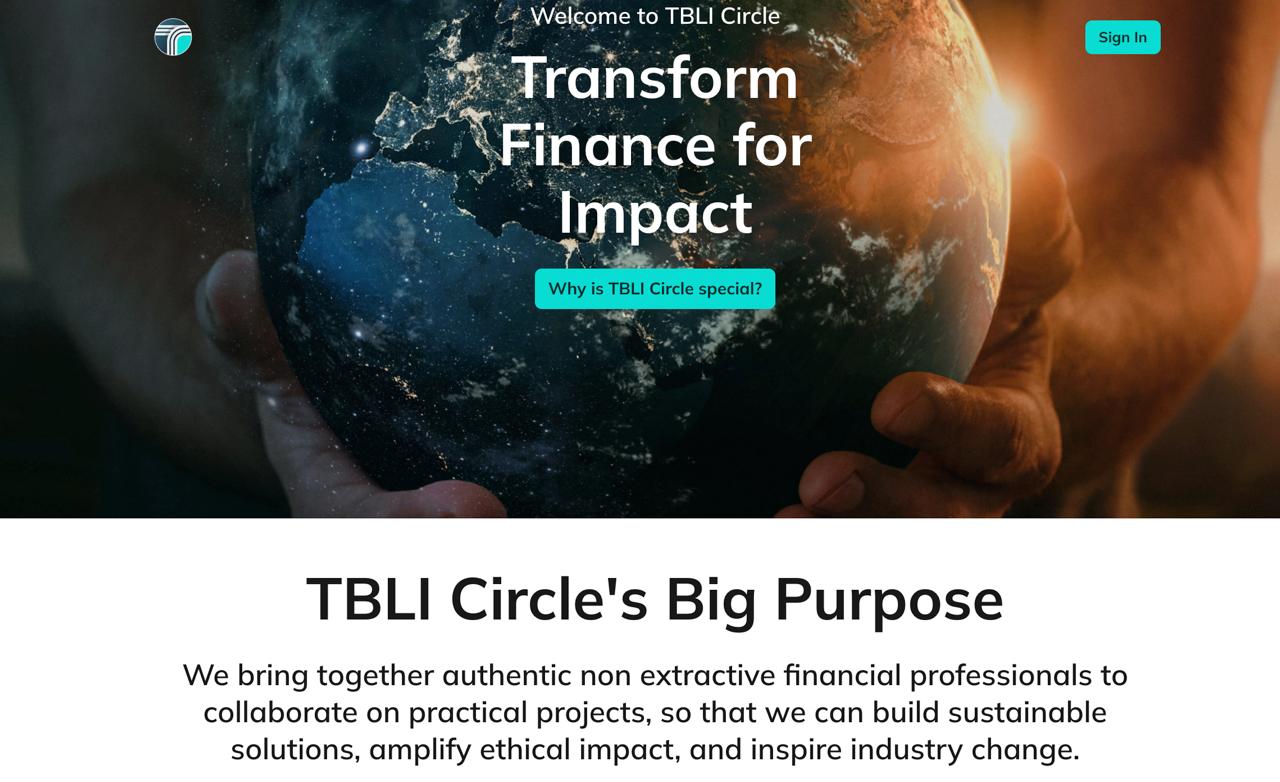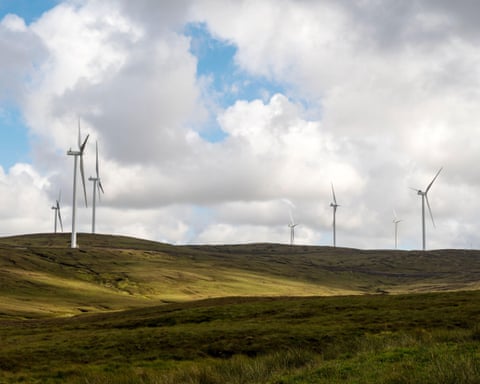
Your weekly guide to Sustainable Investment
TBLI Radical Truth Podcast
Is Nature the Key to Achieving our Climate Goals /w Thomas Crowther

In this episode, we’re joined by Thomas Crowther, ecologist at ETH Zurich, founder of the Crowther Lab and Restor, and one of the most influential scientific voices in global ecosystem restoration. As Chair of the Advisory Board of the UN Decade on Ecosystem Restoration and Chief Scientific Advisor to the UN’s Trillion Trees Campaign, Thomas is at the forefront of efforts to combat climate change through nature-based solutions.
In “Restoring Earth,” we explore the latest science behind ecosystem regeneration, the potential and pitfalls of large-scale tree planting, and the critical role biodiversity plays in stabilizing our climate. Thomas also shares how open-source tools like Restor are connecting communities and investors worldwide to accelerate restoration at scale.
Listen to the full podcast
TBLI Virtual Mixer

What if you could have five meaningful conversations with ESG thought leaders in 90 minutes—without leaving your office?
Traditional networking is broken. Our TBLI Virtual Mixer fixes it with smart matchmaking that connects you directly with the people you need to meet.
Friday, Sept 26th | 16:00-17:30 CET
✅ Intelligent pairing with fund managers and impact investors
✅ Structured 1-on-1 conversations that skip the small talk
✅ Limited to 100 participants
See how it works → (2 min video)
TrustVC
.jpg)
Founders deserve better
Too many get ghosted. Too many LPs find out too late.
That’s why we launched TrustVC.org — the review platform VCs never wanted, but founders and LPs always needed.
✔️ Founders can rate investors
✔️ LPs can spot red flags early
✔️ Fair, founder-friendly firms get recognized
👉 If you’ve worked with investors, leave a review or add a firm today. Let’s bring sunlight to startup funding.
🔗 https://www.trustvc.org/
Just launched: TrustVC.org — the investor review platform VCs never wanted, but founders always needed.
Join TBLI Circle — Transform Finance for Impact

The Future of Finance is Being Written Right Now.
While others debate sustainability, industry leaders are already building it. They're creating the frameworks, closing the deals, and setting tomorrow's standards.
Will you be leading this transformation or watching from the sidelines?
TBLI Circle is where sustainable finance pioneers collaborate on what's next:
Execute breakthrough initiatives that traditional institutions won't touch—yet.
Access deal flow that isn't advertised on LinkedIn.
Shape industry standards before your competitors understand them.
Connect with decision-makers controlling billions in sustainable capital.
The leaders driving this transformation are already here.
The right network doesn't just open doors—it builds new ones.
The Great Consumption Con: Why Your Business Strategy Might Be Building a House of Cards

A wake-up call for leaders who think infinite growth on a finite planet makes sense
The Emperor's New Business Model
Let me ask you something that might make your quarterly projections break out in a cold sweat: What if your entire business model depends on people being perpetually dissatisfied?
Think about it. How many companies in your industry would survive if customers woke up tomorrow and said, "You know what? I'm good. I have enough."
That's not a hypothetical question—it's the inconvenient truth sitting in every boardroom like an uninvited guest at a shareholders' meeting.
The Treadmill Economy
We've built something remarkable: an economic system that requires infinite growth on a planet with finite resources. It's like designing a business plan for a person who needs to gain weight forever. "Sir, you're 200 pounds now, but our five-year projection has you at 400 pounds. Exponential growth, baby!"
The math is beautifully absurd. Three percent annual growth—the holy grail economists worship—means doubling consumption every 23 years. So your great business strategy requires twice as many customers buying twice as much stuff in a generation. Then four times as much in two generations. Then eight times as much.
Does anyone else see the problem here, or are we all just pretending physics doesn't apply to economics?
The Insecurity Industrial Complex
Here's what blows my mind: entire industries exist solely to create problems they can then solve. It's the most elegant business model ever conceived.
The beauty industry convinced half the population that their faces are somehow "unfinished" without daily chemical applications. The tech sector persuaded us that perfectly functional devices become embarrassing liabilities after 12 months. The fashion industry normalized the idea that clothes should disintegrate after a few washes.
We've created what I call "manufactured obsolescence of the soul"—making people feel inadequate about things they never knew they should worry about.
The Hidden Costs of Growth Addiction
While we're busy optimizing quarterly earnings, let's talk about what we're actually optimizing for:
- Environmental bankruptcy: We're liquidating natural capital to show quarterly profits
- Human burnout: The average American works more hours than medieval peasants (yes, really)
- Social isolation: We've traded community for consumption and wonder why mental health is cratering
- Economic fragility: A system that requires infinite growth is, by definition, unsustainable
Meanwhile, countries with shorter workweeks, stronger social safety nets, and less extreme consumption consistently outrank us on happiness and life satisfaction. Funny how that works.
The Revolutionary Business Question
Here's the question that could transform your industry: Instead of asking "How do we get people to buy more?" what if we asked "How do we help people live better?"
I know, I know. Your shareholders just felt a disturbance in the force.
But consider this: Companies built around genuine value creation rather than artificial need generation tend to be more resilient, have higher employee satisfaction, and—here's the kicker—often more profitable in the long term.
What Post-Growth Business Actually Looks Like
Before you panic about becoming a subsistence farmer, let's talk about what a well-being-centered economy might look like for business leaders:
Quality over Quantity: Build products that last, solve real problems, and create genuine value Experience over Acquisition: Focus on services and experiences rather than disposable goods Community over Consumption: Create businesses that strengthen social bonds rather than exploit them Regeneration over Extraction: Design business models that restore rather than deplete resources
This isn't hippie nonsense—it's strategic thinking for long-term survival.
The Competitive Advantage of Enough
Here's the plot twist: Being the company that helps people achieve "enough" might be the ultimate competitive advantage.
While your competitors are fighting over increasingly dissatisfied customers in a race to the bottom, you could be building genuine loyalty with people who appreciate businesses that respect their time, money, and intelligence.
Happy, content customers are actually more valuable than constantly anxious ones. They refer friends. They stick around. They don't need to be manipulated into repeat purchases.
The Bottom Line on Well-being
The most successful businesses of the next century won't be the ones that best exploit human insecurities—they'll be the ones that help humans thrive.
That means measuring success beyond stock prices and quarterly growth. It means considering the actual impact your business has on human well-being, community health, and environmental sustainability.
I'm not suggesting we all start drum circles and abandon profit. I'm suggesting that maybe, just maybe, an economy designed around genuine human flourishing might be more profitable—and definitely more sustainable—than one built on manufactured dissatisfaction.
Read full article
How Climate Risks Are Putting Home Insurance Out of Reach

By: Gilbert M. Gaul
After years underestimating the risks posed by climate-fueled disasters, the U.S. home insurance industry is in turmoil. In vulnerable areas, rising insurance costs are upending housing markets and communities, as homeowners scramble to try to find insurance they can afford.
For decades, Sanibel Island, one of the most treasured vacation resorts in America, was an insurance agent’s dream. Year after year, the 5,000-odd residents of the barrier island on Florida’s Gulf Coast wrote checks for their home and flood insurance policies, but rarely filed claims. Insurers collected over $10 in premiums for every dollar they paid out, a remarkable return on their business.
Then, in September 2022, Ian, a bruising Category 4 hurricane pushed up to 12 feet of water across the low-lying island, collapsing part of the only causeway on and off Sanibel, flooding thousands of single-family homes and condominiums with brackish water, and forcing some year-round residents into exile for over a year. Two more hurricanes, Helene and Milton, in 2024 added to the island’s misery.
The damage was both staggering and surprising. It had been years since Sanibel experienced a hurricane of any consequence. Officials had also taken steps to reduce their risks, limiting development to a third of the 12-mile-long island and setting aside land for a federal wildlife preserve. Still, Sanibel is only a few feet above sea level and many older homes are at ground level.
“We had so many good years, 30 or 40 years, we were spoiled,” said Daniel Moore Thompson, whose two-bedroom house and gift shop flooded. “And then Ian happened, and it was like we lost our innocence. I basically lost everything except my Jeep and dog.”
In a matter of hours, Sanibel went from being an insurer’s dream to a financial nightmare. The National Flood Insurance Program (NFIP), which sells most flood policies, was hit with $620 million in claims, a nearly hundredfold increase from the total that it had paid Sanibel homeowners over the previous four decades.
But Sanibel wasn’t the only Southwest Florida community to suffer a dramatic reversal of fortune. Homeowners in Fort Myers Beach, Cape Coral, and Punta Gorda received over $1 billion in flood payouts, records show. Meanwhile, property insurers covering wind and other damages paid billions more, helping to make Ian one of the costliest hurricanes in history.
For insurers, the three hurricanes were a rude awakening. After years of underestimating risks posed by climate-fueled storms, wildfires, and other natural disasters, the industry now faces a perilous future. Old models based on stable climates are being challenged by more frequent, extreme, and damaging events — from searing wildfires in the coastal canyons of California, to hail and torrential rain in the Midwest, to explosive hurricanes such as Ian in Florida, Louisiana, and Texas. Now, as sea levels rise, drenching rain storms swell rivers, and hail the size of baseballs pound roofs and cars, the increased costs are pushing insurers to the limit, upending housing markets, and even reshaping the makeup of some communities.
“The insurance crisis in the U.S. is the canary in the coal mine, and the canary is dead,” said Dave Jones, the insurance commissioner of California from 2011-2018 and now director of the Climate Risk Initiative at the Center for Law, Energy and Environment at the University of California, Berkeley. During his time as commissioner, wildfires exploded in Paradise and Malibu, resulting in billions in damages. Coupled with the Trump administration’s aggressive moves to roll back climate initiatives, Jones fears: “We are marching toward an uninsurable future in this country and across the globe; marching into the abyss.”
Jones isn’t alone in such dire warnings. Testifying this February before the Senate Banking Committee, Federal Reserve Chairman Jerome Powell predicted that “in 10 or 15 years there are going to be regions of the country where you cannot get a mortgage [because insurance isn’t available].”
Even more recently, the economists and climate analysts Carolyn Kousky, Spencer Glendon, and Barney Schauble raised the idea that the future may be uninsurable. “As natural disasters grow more frequent, extreme, and damaging, more people and businesses are struggling to afford — and even get — insurance,” they wrote in a recent article. “In places of increased climate risk from disasters such as fires and storms, insurance has gone from an afterthought to a source of concern, dismay, and anger.”
Read full article
The government has laid out the perils of the climate crisis – but will Albanese meet the moment?

Grave remarks on the potential shocks to people, property and the economy are all too familiar. Putting a credible number on the emissions target is the harder part
It is hard to imagine there will be a more important piece of work put out by the Albanese government in this term of parliament than the national climate risk assessment. It suggests that at more than 2C of global heating – a level we are headed towards on our current trajectory – the systems Australians rely on could start to crumble and collapse.
That’s an easy thing to say, but a hard thing to get your head around. There was a huge amount of information released on Monday, including an adaptation plan that is only the start of grappling with the problem, and it will take time to digest. But it is worth considering what the assessment led by the Australian Climate Service says about the country’s economic future if global emissions are not curbed and temperatures continue to rise.
Across three scenarios, it describes the likelihood of climate-driven events triggering “cascading shocks” to the financial system. Supply chains are likely to be disrupted, leading to goods shortages – a trend that has already begun in areas hit by floods and cyclones. Energy supplies and telecommunications could fail. Assets could be written down and loans defaulted across a region. Households and businesses then may not have access to finance, and the value of investments and superannuation could fall.
What happens then? The ramifications could make an increase in inflation or interest rates seem trivial by comparison.
Economic risks are just one focus of the assessment. It also details what rising temperatures will mean for health and social support systems, including a rise in deaths and hospital admissions from heatwaves, which already kill more people than all other forms of extreme weather.
On sea level rise, the assessment found that more than 1.5 million people could be living in areas at risk of coastal flooding in 2050. On the natural environment, it reinforces that Australia is likely to lose ecosystems and species by the middle of the century. This would be a tragedy in its own right, and could affect people’s access to clean air, water and food. Infrastructure, primary industries and national security could all face substantial disruption.
How does this square with the environment minister, Murray Watt, confirming on Friday he had approved a potential 40-year life extension for the North West Shelf liquified natural gas export facility, one of the country’s biggest polluting sites? Not easily, to put it mildly.
It could lead to new gas basins being opened and billions of tonnes of carbon dioxide being pumped into the atmosphere. The decision has prompted anger and understandable accusations of hypocrisy.
Asked about this as he released the assessment on Monday, the climate change minister, Chris Bowen, replied that the government had been upfront about the “complicated and complex challenges” of transitioning to net zero emissions. He then pivoted to use the assessment to frame the release of another big piece of government work – its 2035 emissions reduction target, which is expected within days.
On this, the minister made a forceful case for action. He said people were already living through the climate crisis, that it would have “compounding, cascading and concurrent”affects across the country, and touch the lives of every Australian. He repeatedly stressed that, no matter what other countries did, the “cost of inaction will always outweigh the cost of action”. We must get on with it, in other words.
Bowen argued the government’s seriousness on climate action would be “very clear” from coming announcements. “We’ll be holding the course on climate action because it’s in the best interest of our country. And we’ll be decarbonising our own economy, and we’ll be helping other economies decarbonise as well,” he said.
Right now, it’s anyone’s guess what “holding the course” will mean when cabinet meets to finalise the 2035 emissions target range – and there is no shortage of guesses. Bowen has cautioned not to over-interpret his comments on the subject. He said he did not receive the Climate Change Authority’s final advice on the target until Friday.
But he did set a benchmark earlier last week when he volunteered that the Intergovernmental Panel on Climate Change had found limiting global heating to 1.5C above preindustrial levels would require a 68% global cut between 2005 and 2035.
Developed countries such as Australia would be expected to do more than 68% for there to be any chance of that global average being met. Several analysts say it must stretch to 75% or beyond. But from the government’s perspective, Bowen’s statement was an acknowledgment that anything less than 68% could not be sold as consistent with climate science.
It suggests the minister believes a target range that includes at least that level of emissions reduction is necessary and achievable. The question is whether Anthony Albanese does.
Read full article
Weakening net zero policy ‘will spook investors’, warns UK’s climate adviser

Nigel Topping says shifting course risks deterring capital, as he urges ministers to hold firm on green transition
How a profit-sharing agreement could be a new model for mining on Indigenous land

The unprecedented deal the Shoshone-Paiute struck with a Canadian gold company will test whether mining can align with Indigenous rights.
In 2020, when Brian Mason began his first term as Chairman for the Shoshone-Paiute Tribes of the Duck Valley Reservation, gold miners came calling. Just a few years before, Integra Resources, a Canadian mining company, had acquired an abandoned gold and silver mine on the tribe’s homelands in southwestern Idaho, but before work began, they had an unusual request: Could the tribe and the company establish a partnership that would benefit both?
“There are a lot of things that were different as we started to work with Integra,” Mason said. Early efforts included invitations to tribal members to the mine while impact studies were conducted as well as initial site surveys.
Historically, mining has been ecologically costly and even deadly to Indigenous peoples around the world. The industry is also notorious for ignoring meaningful consultation with Indigenous communities and outright ignoring human rights. Even in the United States, mining companies have often operated with carte blanche in Indian Country.
Last month, for instance, the Nez Perce Tribe, located north of Duck Valley in Idaho, sued the Forest Service for approving an open-pit gold mine that the tribe says will pose cultural and ecological risks to their homelands. In Arizona, a proposed copper mine on Oak Flat, a sacred site, has been in and out of court since 2014, and ongoing resistance has led President Donald Trump to call tribal members who are against the mine “anti-American”.
For Duck Valley, the question was: How do you draw up an agreement that benefits the tribe with an industry that has thrived on theft and dispossession? The answer was surprisingly simple: Include the nation as development partners in a framework that recognizes tribal sovereignty and self-determination.
Mining operations, and most especially projects connected to transition minerals, become more expensive when companies mine in Indigenous territories without working with Indigenous peoples. In 2023, a federal judge ruled that Enel Green Power, a wind turbine developer, trespassed on Osage Nation lands when it built a wind farm, creating a legal precedent that has shifted the way developers navigate projects and made meaningful tribal consultation a cost-cutting measure for businesses.
“We don’t do this as an ideological sort of effort,” said Mark Stockton, Integra’s vice president of sustainability, with regards to the Duck Valley deal. “It creates resilience in our business. It creates predictability and durability.”
Last month, the Shoshone-Paiute and Integra signed a legally binding agreement to develop and oversee the gold and silver mining project, sharing profits and establishing, within the decade-long timeline of the mine’s active operations, initiatives that will support the tribe’s economic development and language revitalization efforts. But what makes the agreement stand apart from others is its commitment to the United Nations Declaration on the Rights of Indigenous Peoples, or UNDRIP, an international standard for the rights of Indigenous peoples. While other projects, such as the Anahola Solar Project in Hawaiʻi, coordinated a partnership with Indigenous Hawaiians under an UNDRIP-style framework, Integra says its agreement with Duck Valley is a first in the Lower 48.
Maranda Compton, the Founder of Lepwe, an organization that consults tribes and developers in sectors such as mining, focuses on agreements and publishing guidelines that benefit tribes in other sectors through UNDRIP. “My joke is always that consultation is basically the federal government coming to a tribe and saying, ‘How much do you hate this project on a scale from one to you’re going to sue us?’”
Compton co-authored a white paper earlier this year with the Tallgrass Institute, an organization focused on Indigenous economic stewardship, detailing the way industries are shifting to respect UNDRIP and pursue coordination with tribal nations, a move that includes developers engaging in revenue sharing and continuous oversight over projects with tribes.
Chairman Mason says the demand for metals and minerals has a big impact on his tribe, especially in the neighboring state of Nevada, where Shoshone-Paiute lands are also located. “If Nevada were its own country, it’d be the fourth-largest gold producer in the world,” he said. But the state’s also been embroiled in multiple disputes with tribal nations — notably, the Thacker Pass mine project, the largest known deposit of lithium, a mineral used for electric vehicles and a sacred site for tribes, including the Reno-Sparks Indian Colony and Summit Lake Paiute. Beyond a lack of meaningful tribal consultation to mine Thacker Pass, generating an international rights violation report by Human Rights Watch, Mason noted there are no profit-sharing agreements in place and none have been proposed. On top of that, federal mining law allows companies to claim land cheaply while avoiding payments on royalties for use of that land.
“The tribes have never been subject to any of that revenue,” said Mason. “We’ve argued with the U.S. government on that, we’ve argued with the state about it, trying to get some revenue to the tribes in some form of a mineral tax.”
But many tribes in the region, including the Shoshone-Paiute, are known as “nonrevenue” tribes: a tribal nation with an economy solely supported by grants and federal funding. For the Shoshone-Paiute, that has meant 85 to 90 percent of all revenue comes from federal sources. But because funding is contingent on available funding, nonrevenue tribal economies are often unstable.